|
Take A Shot at Collecting Arcade Targets
By Richard & Valerie Tucker
Posted October 2015

It was about 1983 when we purchased our first shooting gallery target. It was a blue row of white doves that we found at the Home in Indiana show in Indianapolis. Years later, we realized that what we had was a row of birds from a much larger rack produced by the WF Mangels Company of Coney Island fame. What drew us to this purchase was not that these were targets but rather that they were figural cast iron—an early passion which still exists today.
We have been collectors all of our adult lives, first as collectors of contemporary art and sculpture that in the late 1970s and early 1980s was actually somewhat affordable. When we moved to the country in the early 1980s, our interests evolved into an appreciation for early painted furniture, smalls and other forms of Americana. The target and other eye-catching arcade forms, such as the penny pitch, bottle, ball toss knockdown and game wheel, were natural adjuncts and complements to our other collecting interests.
|
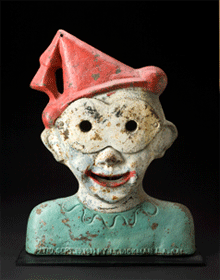
A Great Clown target by JT Dickman of Los Angeles, 15.25 x 20.25.25 inches, made of cast iron; original surface and signed with the patent date on the front.
|
As with most collectors we have known, the chase becomes all-consuming. Every variation, no matter how slight, must be found and coveted. It is simply not enough to own one dove, owl, rooster, dog or cat. No—every example is prized, and why not own 50, 100 or more cast iron knockdowns of birds of varying shapes and sizes when probably one will do? The lack of space to display the newest "treasure" is never a consideration as there is always room in the attic, garage, basement or mini-warehouse.
One of the most common clichés is that it is all about the chase. It is not the "find" of a heretofore unknown form (that is anticlimactic at least to us), but rather the heart-thumping drive in a car or plane flight to an auction, show or home to see what awaits. Indeed, we recall reading somewhere that a book collector once summarized his collecting passion as, “The finding was perhaps more rewarding than the having.” And so it has been with us.
|
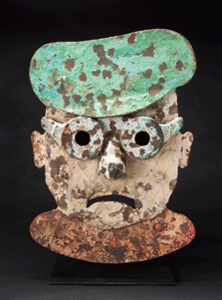
|
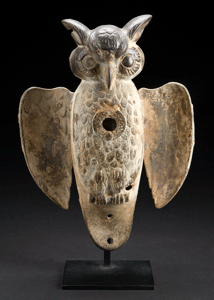
|
|
A Rowdy target by WF Mangels of Coney Island, 22 x 27 inches (face), cast iron with applied cast iron and large spectacles.
|
An Owl target by CW Parker of Abilene and Leavenworth, Kansas, cast iron; 11.5 inches (including flapping wings) x 15.5 inches. Wings flap when the bulls-eye is hit.
|
For us, the progression from contemporary art and sculpture to the world of the target, arcade and painted American furniture and accessories has been a natural evolution. After all, it is the beauty of the form and condition of the object that is common to all collectors. And what is more natural than being attracted to bulls eyes and other arcade forms when you have collected the likes of Jasper Johns and Kenneth Noland with the bulls eye as common imagery, Frank Stella and his early concentric squares to Andy Warhol, Wayne Thiebaud and Claes Oldenburg for their Pop Art imagery? They all grew up during the 1930s and 1940s when the arcade was still enormously popular. Could their later imagery have been influenced by their appreciation and fascination, as others have been, by the gallery and arcade?
The American shooting gallery and arcade, dating from the third quarter of the 19nth century and having taken its inspiration from European counterparts, is for the most part from an era of American culture and entertainment of a bygone period. Shooting galleries and arcades of the permanent variety on midways, boardwalks and in amusement parks as well as those in bars, saloons and stores, and the portable varieties experienced at circuses and county and state fairs and transported behind trucks, using live ammunition, are a thing of the past. (Although occasionally, a gallery surfaces such as those at Coney Island, Reynolda House in Winston Salem, N.C., or the Sandy Chanty Restaurant in Geneva on the Lake, Ohio.) Lifestyles have changed and real estate prices have gotten too high, and as the result of two world wars that needed the iron for munitions, families moving to the suburbs, and greater mobility for travel and entertainment, this truly American form of entertainment has largely disappeared.
|
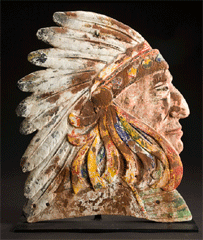
|
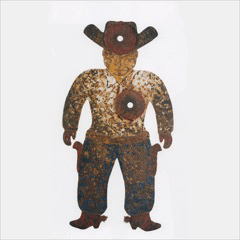
|
|
Indian Chief by Smith, Hoffmann or Mueller, 16 x 19.5 inches. This target would have had a clay pipe in the mouth.
|
A Cowboy target by WF Mangels of Coney Island, cast iron, 28 x 53.5 inches.
|
Our collecting passion (some might say obsession) in this area has been accompanied by our intellectual curiosity as to who made the targets and arcade objects. This curiosity has manifested itself in our searching out and acquiring numerous catalogs, photographs, postcards, trade cards and other ephemera. Until our book Step Right Up! Classic American Target and Arcade Forms was published in 2014, there was no reference book that could provide this type of information.
From our research, we have determined that there were approximately 20 known American manufacturers of the shooting gallery. It is unknown how many manufacturers made the related arcade objects because, for the most part, these objects had no identifying markings. The same is generally true for the shooting gallery target. Except for CW Parker of Abilene and Leavenworth, Kansas, and William Wurfflein of Philadelphia, who almost always marked their targets, target forms also had no identifying marks. Unless one has access to the type of ephemera that we have accumulated, it would be nearly impossible to identify a maker.
The most prominent of the American target manufacturers was WF Mangels of Coney Island who operated as a manufacturer of shooting gallery and other amusement devices. Other prominent manufacturers were: CW Parker, WF Wurfflein, JT Dickman of San Francisco and four Chicago manufacturers, HC Evans, Emil Hoffmann, FC Mueller and AJ Smith.
|
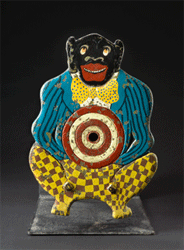
|
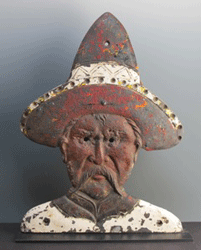
|
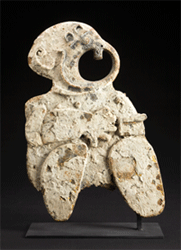
|
|
Suit Monkey by HC Evans or FC Mueller of Chicago, cast iron, 10 x 14.75 inches.
|
Mexican Head target by Emil R Hoffmann of Chicago, cast iron, 15.75 x 21.5 inches.
|
Baby Snookums by JT Dickman of Los Angeles, Calif., cast iron, 14.5 x 19.5 inches.
|
In general, American target forms were small in size, made of cast iron, depicted animals and were conveyor-belt driven or stationary. Many were politically incorrect, such as the Indian, baby, Mexican or African-American. European targets, to the contrary, were large and highly detailed, made of sheet metal, hand painted, intricately designed and depicting humorous everyday scenes. None were marked to indicate a maker.
Mangels’ targets are the most common and easiest to find, at least in the more common forms such as ducks, birds and geometric shapes. The targets manufactured by Parker, Wurfflein and Dickman are, for some reason, the rarest with few examples surviving. Those manufactured by Parker and Wurfflein were the most influenced by the European tradition in terms of subject matter, design and construction. Almost without exception, the manufacturers’ catalogs depicted artist renderings of galleries, targets and other arcade objects and devices rather than actual photographs. Many of the forms depicted have never surfaced, either because they were never actually produced or didn’t survive.
Collecting in this area has produced a number of unanswered questions. Why have only a few Mangels and one HW Turpening of California gallery survived? Why are there no known photographs or other evidence of actual Parker, Wurfflein or Chicago Manufacturer galleries having actually been produced? Why are there numerous Mangels and Chicago Manufacturer forms surviving but so few identifiable Parker, Wurfflein, Dickman and Terpening forms which have survived? Why do Parker targets for the most part have the same unpainted patina? Why do so many of the Wurfflein targets seem to have original painted surface? Why do so many forms show up in the catalogs of different manufacturers? Was it that the copyright laws were just not as developed 100 years ago so that infringement was less of an issue, or did the various manufacturers sell to one another or use subcontractors who sold the forms to multiple users? Why are so many forms of a common theme? Unfortunately, no oral histories or business records have survived to answer these questions.
Luck has played a large part in our collecting in this area. But knowledge is king! Not every bird or duck is common. Many forms that on first glance appear to be identical are actually different, resulting in significant differences in value. Our experience has shown us that common forms are often overpriced, while rare forms are often undervalued. Forms are often misrepresented as to rarity, condition and maker, as well as to whether they are actually target or arcade objects at all. Fortunately, few forms have been reproduced so far but with the advent of the 3D printer and other modern technology, as well as an increase in value, reproductions will probably surface in the future.
So, what should one look for? Condition and rarity are the most important considerations. Don’t expect objects to have original surface or to be in pristine condition and without flaws. After all, they shouldn’t be, as these objects were shot at and thrown at countless times over countless seasons. These objects were subjected to abuse and were repainted and repaired constantly. Some damage is expected and acceptable, but major damage will substantially detract from the value and even the advisability of acquisition.
Collecting targets and arcade objects is a specialized area. There is a crossover appeal for not only the target and arcade object collector but also for the collector of cast iron, folk art, Americana and advertising and ephemera. If you collect in one or more of these areas, collecting targets and arcade objects may just be of interest to you.
---------------------------------
Step Right Up! Into the Colorful World of the American Shooting Gallery and Arcade. Richard and Valerie Tucker have been collecting American contemporary art and folk art since their marriage in 1966. Their love of painted surfaces inspired their initial interest in collecting figural cast iron, including shooting gallery targets and other arcade forms. Friends along the way encouraged them to write this book and share their knowledge with others who had the same regard for this art form. Richard and Valerie live in Boulder, Colorado, with their two cats, CJ (Bobo) and Willie.
|